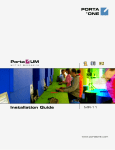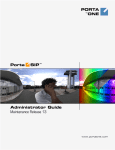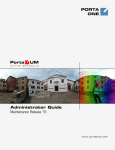Download Asus P4VP-MX Installation guide
Transcript
PORTA ONE Porta SIP TM Installation Guide Maintenance Release 16 www.portaone.com Porta SIP Copyright notice & disclaimers Copyright © 2000-2008 PortaOne, Inc. All rights reserved PortaSIP Installation Guide, April 2008 Maintenance Release 16 V1.16.3 Please address your comments and suggestions to: Sales Department, PortaOne, Inc. Suite #400, 2963 Glen Drive, Coquitlam BC V3B 2P7 Canada. Changes may be made periodically to the information in this publication. Such changes will be incorporated in new editions of the guide. The software described in this document is furnished under a license agreement, and may be used or copied only in accordance with the terms thereof. It is against the law to copy the software on any other medium, except as specifically provided in the license agreement. The licensee may make one copy of the software for backup purposes. No part of this publication may be reproduced, stored in a retrieval system, or transmitted in any form or by any means, electronic, mechanical, photocopied, recorded or otherwise, without the prior written permission of PortaOne Inc. The software license and limited warranty for the accompanying products are set forth in the information packet supplied with the product, and are incorporated herein by this reference. If you cannot locate the software license, contact your PortaOne representative for a copy. All product names mentioned in this manual are for identification purposes only, and are either trademarks or registered trademarks of their respective owners. (c) 2000-2008 PortaOne, Inc. All rights Reserved. www.portaone.com 1 Porta SIP Table of Contents Preface ............................................................................................................................ 3 1. Introduction ..................................................................................4 Hardware and Software Requirements ............................................................... 5 2. Installation Process.....................................................................7 Step Step Step Step Step Step Step Step Step Step Step Step Step Step Step Step Step Step 1: Insert USB Dongle....................................................................................... 8 2: Power-up, Boot Order Setup ................................................................... 8 3: Insert CD-ROM ............................................................................................. 9 4: Launch Installation Process ..................................................................... 9 5: Welcome Screen ........................................................................................ 11 6: Hardware Check......................................................................................... 11 7: STUN Feature and RADIUS Configuration – Parameters ............ 12 8: Network Configuration............................................................................. 13 9: Time Zone Configuration ........................................................................ 14 10: Disk Partitioning - Overview................................................................ 14 11: Disk Partitioning - Choose Disk.......................................................... 14 12: Disk Partitioning, Slice Layout ............................................................ 15 13: Set Up Root Password and User Account ...................................... 15 14: Start Installation...................................................................................... 16 15: Installing Required Applications......................................................... 16 16: Prepare to Reboot................................................................................... 18 17: Check If System Can Reboot to Normal State ............................. 19 18: Prepare System for Transport (Optional)....................................... 20 (c) 2000-2008 PortaOne, Inc. All rights Reserved. www.portaone.com 2 Porta SIP Preface This document provides a general overview of the PortaSIP installation process. Where to Get the Latest Version of This Guide The hard copy of this guide is updated at major releases only, and does not always contain the latest material on enhancements occurring between minor releases. The online copy of this guide is always up to date, and integrates the latest changes to the product. You can access the latest copy of this guide at: www.portaone.com/support/documentation/ Conventions This publication uses the following conventions: Commands and keywords are given in boldface Terminal sessions, console screens, or system file names are displayed in fixed width font Caution indicates that the described action might result in program malfunction or data loss. NOTE: Notes contain helpful suggestions about or references to materials not contained in this manual. Timesaver means that you can save time by performing the action described in the paragraph. Tips provide information that might help you solve a problem. (c) 2000-2008 PortaOne, Inc. All rights Reserved. www.portaone.com 3 Porta SIP Introduction 1. Introduction (c) 2000-2008 PortaOne, Inc. All rights Reserved. www.portaone.com 4 Porta SIP Introduction PortaBilling can potentially run on most modern UNIX operating systems, assuming these are equipped with such basic items as an ANSI C compiler. However, it might be difficult for an inexperienced system administrator to install and configure the operating system in such a way as to meet all the requirements and provide the best performance. Installing all the prerequisite software (libraries, Perl modules, SIP proxy server, B2BUA, RTP proxy etc.) might also be a time-consuming task, with a high risk of making some hard-to-trace error. The PortaSIP JumpStart installation CD provides a quick and seamless way to perform a complete server installation from scratch, in less than 15 minutes. It contains installation media for FreeBSD 6.3, with all the necessary packages and PortaSIP itself. The standardized installation procedure also simplifies further system maintenance. The installation wizard makes use of a text-mode GUI. Use the arrow keys to change your selection, Tab to move between fields, and Enter to confirm a choice. Hardware and Software Requirements NOTE: If you wish to perform testing to determine whether PortaSwitch can be installed on a specific server, please use the “Hardware Compatibility” CD provided by PortaOne. You can download the CD image from: http://portaone.com/resources/hw_test/HardwareCompatibilityCD.iso Burn it to a CD using any CD-writing program, then boot up from this CD. The PortaSwitch test utility will detect if all of the required components (e.g. network interface) are available and supported by FreeBSD. Recommended Configuration: PortaSIP: • • • • CPU: basic configuration: Pentium4 2.8GHz advanced configuration: Pentium4 3GHz SCSI integrated or add-on hardware RAID controller compatible with FreeBSD 6.3 RAM: 1GB Disks: basic configuration: at least 50GB of the available disk space (RAID: (c) 2000-2008 PortaOne, Inc. All rights Reserved. www.portaone.com 5 Porta SIP • • • Introduction mirroring or RAID5) advanced configuration: at least 80GB of the available disk space (RAID: mirroring or RAID5) Network interface USB Port ATAPI or SCSI CD-ROM drive Please check that the other hardware installed in your server (such as network adapter, RAID controller, and so on) is supported by FreeBSD. You can check this at the FreeBSD website: http://www.freebsd.org. During installation you will be prompted for the network configuration parameters. Please make a decision regarding these before installation, consulting your network administrator if necessary. It is possible that you will have to perform installation while the network is not yet available (from your office, for example, while the servers will be placed in a server hosting center), but you will need to enter the correct data anyway. Please have the following ready: • • • IP addresses of the PortaBilling100 master server PortaSIP IP address, subnet mask and address of the default gateway DNS server address If you have a hardware RAID controller in your system, configure the RAID array. The recommended configurations (depending on the amount of hard drives in the system) are as follows: • • 2 disks – RAID (mirroring) 3 disks – RAID 1 (mirroring) on the first two disks, third one left as a hot spare (c) 2000-2008 PortaOne, Inc. All rights Reserved. www.portaone.com 6 Porta SIP Installation Process 2. Installation Process (c) 2000-2008 PortaOne, Inc. All rights Reserved. www.portaone.com 7 Porta SIP Installation Process Step 1: Insert USB Dongle Before you start the installation, insert the USB dongle provided into one of the available USB ports. It must remain in place the whole time to ensure normal system operation. Step 2: Power-up, Boot Order Setup Turn on the computer which you plan to use as the server. Enter the BIOS setup and make sure that: • the CD-ROM is first in the list of boot devices • USB support is enabled If you are installing a dual-server configuration, start your installation with the master server. NOTE: This image is only an example. The BIOS on your system might look different. Save your changes and exit. (c) 2000-2008 PortaOne, Inc. All rights Reserved. www.portaone.com 8 Porta SIP Installation Process Step 3: Insert CD-ROM While rebooting the system, insert the PortaSIP installation CD into the CD-ROM drive. If you do not insert it soon enough and get a “no operating system” error (or a previously installed operating system starts its boot-up process) then press Reset and ensure that you are booting from the CD. Step 4: Launch Installation Process First, you will be asked to boot from the CD. You will know that JumpStart installation has begun if you see a screen similar to the following one: (c) 2000-2008 PortaOne, Inc. All rights Reserved. www.portaone.com 9 Porta SIP Installation Process Before proceeding any further, you will see the following screen: If you select the first option, installation will start in default mode, which is suitable for most hardware configurations. However, in some cases, option 1 will return a device mounting error due to hardware conflicts. In this case, restart installation and, when you see this screen again, select options 2, 3 or both to enable/disable APIC/ACPI features. For example, if you are installing to a computer with an ASUS P4VP-MX motherboard, you must disable APIC. In this case, select 2 on the screen above. You will then be shown the disabled features and asked to press 1 or Enter to proceed, as shown in the screen below: (c) 2000-2008 PortaOne, Inc. All rights Reserved. www.portaone.com 10 Porta SIP Installation Process Step 5: Welcome Screen Next, the installation process starts. First you will see the PortaSIP welcome screen: Press Enter to continue. Step 6: Hardware Check Next, the system will check your server’s hardware components, such as CPU, memory, network card and USB controller. If the hardware test detects a failure, an output message is generated indicating what exactly went wrong when failure occurred. (c) 2000-2008 PortaOne, Inc. All rights Reserved. www.portaone.com 11 Porta SIP Installation Process Step 7: STUN Feature and RADIUS Configuration – Parameters If you set the STUN feature, you should have two IP addresses ready for network configuration. You can set the checkbox for the STUN feature using the space bar. Parameter RADIUS server RADIUS secret RADIUS auth port RADIUS acct port RADIUS retransmission interval RADIUS retransmission count Description IP address of the PB100 master host. Authentication key for all radius interactions; select a password and write it down, as you will need to enter it later when adding the PortaSIP node to your PB100 system. Number of the UDP port on which your PortaBilling100 accepts authorization requests. Number of the UDP port on which your PortaBilling100 accepts accounting requests. Number of seconds to wait for a reply before retransmitting a RADIUS request. Maximum number of retransmissions. NOTE: Only RADIUS server and RADIUS key are mandatory parameters. You can simply leave the default values for the last four parameters. (c) 2000-2008 PortaOne, Inc. All rights Reserved. www.portaone.com 12 Porta SIP Installation Process Step 8: Network Configuration Fill in the appropriate fields for network configuration in this menu. Use the space bar to set the check box for Interfaces and DHCP. Use the Tab key to proceed to the next field. If you have multiple interfaces, set at least one of the interfaces on which your machine connects to the Internet. If you do not use DHCP, unset this box. You can leave the alias and ifconfig(8) flags field empty. However, if you set the STUN feature in the previous screen, you must fill in the alias IP field for the selected interface, or choose a secondary interface and fill in the IPv4 address for it. If you fail to do so, you will be prompted to reconfigure the network as shown below: (c) 2000-2008 PortaOne, Inc. All rights Reserved. www.portaone.com 13 Porta SIP Installation Process Step 9: Time Zone Configuration Proper adjustment of your clock and time zone is essential in order to achieve accurate billing. Usually people choose the time zone where the server is physically located, or the one which is local to the majority of system administrators. Step 10: Disk Partitioning - Overview Now you must allocate the hard drive partitions where FreeBSD and PortaSIP will be installed. If you have only one hard drive in your system, or have configured your available disks as a single volume array, go to step 12 directly. Otherwise, choose the designated disk in step 11. Step 11: Disk Partitioning - Choose Disk If you have more than one disk in your system, you will have to choose which disk you would like to create the FreeBSD partitions on. If in doubt, choose the first disk in the list. NOTE: Installation is always performed on a single disk. If you want to utilize multiple drives (e.g. install the DB on a separate disk), this can be done after installation. (c) 2000-2008 PortaOne, Inc. All rights Reserved. www.portaone.com 14 Porta SIP Installation Process Step 12: Disk Partitioning, Slice Layout You will be prompted to enter or choose the slice sizes for holding different file systems. The default settings are OK in most cases. Step 13: Set Up Root Password and User Account Choosing the super user password is very important, as you will need it to perform system administration or system recovery. Choose a password which is difficult to guess or crack. Add another user account especially for remote administration. . (c) 2000-2008 PortaOne, Inc. All rights Reserved. www.portaone.com 15 Porta SIP Installation Process Step 14: Start Installation Your confirmation is required before the disk layout is changed and the partitions reformatted. Press Enter to proceed. Step 15: Installing Required Applications When installation starts, you will see a screen similar to the one below. At this step, the installation program will install all the required third-party applications, such as MySQL client and PortaSIP software. This step may take 5-10 minutes. (c) 2000-2008 PortaOne, Inc. All rights Reserved. www.portaone.com 16 Porta SIP Installation Process During installation you will be asked to enable SIP features on your PortaBilling web interface. If you select Yes on the screen above and do not have IP connectivity to the PortaBilling slave machine, you will be prompted by the following screen. Choose No to proceed if you do not have such connectivity. (c) 2000-2008 PortaOne, Inc. All rights Reserved. www.portaone.com 17 Porta SIP Installation Process The installation continues, and you may follow its progress: Step 16: Prepare to Reboot When installation has finished and you reach the following screen, press Reboot. After the system has begun its reboot process, remove the installation CD from the CD-ROM. (c) 2000-2008 PortaOne, Inc. All rights Reserved. www.portaone.com 18 Porta SIP Installation Process NOTE: Do not forget to enter BIOS again and change the priority of the boot devices so that the hard drive will be attempted first. (This ensures a quicker reboot when recycling the server.) Step 17: Check If System Can Reboot to Normal State It is good to make sure that the system is in a stable state, and that it returns to normal operations without intervention on reboot, especially if there is no keyboard or other peripheral attached. Following a normal reboot, the screen should look like this: Press Ctrl + Alt +Del if you need to reboot. (c) 2000-2008 PortaOne, Inc. All rights Reserved. www.portaone.com 19 Porta SIP Installation Process Step 18: Prepare System for Transport (Optional) If you need to transport the system to another location (e.g. hosting center), or otherwise power down the system safely, proceed as follows: • Wait until the system finishes booting • Log in as root • Type shutdown -p now • Wait until either the system powers down on its own or the “The operating system has halted” message appears, and then power off the server. (c) 2000-2008 PortaOne, Inc. All rights Reserved. www.portaone.com 20































